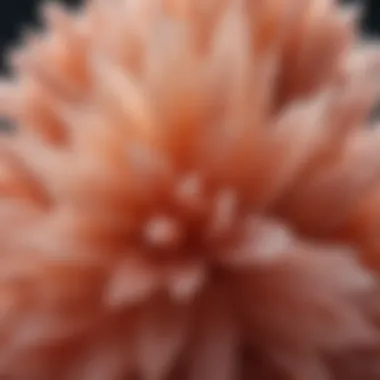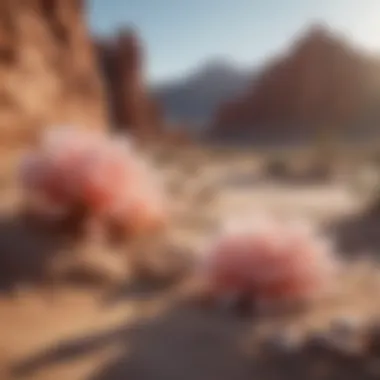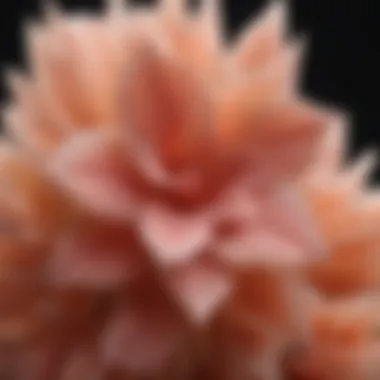Exploring Desert Rose Selenite: A Unique Mineral


Intro
Desert rose selenite, an eye-catching mineral known for its intricate structure, combines natural beauty with unique formation processes. This guide highlights its characteristics, formation, and various uses. Knowledge about this mineral is especially valuable for rock and fossil collectors, who appreciate its aesthetic appeal and geological significance.
History and Origins
Desert rose selenite has a rich history intertwined with the geological underpinnings of our planet. Formed primarily in arid environments, this gypsum-based mineral takes shape in desert conditions. The combination of moisture, wind, and occasional rain contributes to the growth of these stunning formations.
Overview of Collectibles, Rocks, and Fossils
Mineral collectors often seek out exceptional specimens like desert rose selenite. This mineral holds a unique position within collections, appealing due to its rarity and visual impact. Collectors may find specimens in various sizes, each showcasing distinct forms and crystal arrangements. As such, it serves not only as a decorative piece but also as an intriguing subject for study.
Historical Significance and Cultural Impact
Throughout history, desert rose selenite has been revered in many cultures. Its striking appearance made it a favorite among artists and artisans. Some believed that its unique shape contained protective properties. The mineral influenced local industries, leading to its incorporation into various cultural artifacts and jewelry.
Identification and Classification
Proper identification is crucial when seeking desert rose selenite. Certain key features distinguish it from other minerals, making the identification process straightforward for experienced collectors and novices alike.
Guide to Identifying Rocks and Fossils
When identifying desert rose selenite, collectors should look for the following characteristics:
- Color: Typically soft beige to brown hues.
- Texture: The surface feels smooth but has a distinct form that resembles rose petals.
- Shape: Clustered, rosette-like formations are a signature characteristic.
Common Types and Variations
Desert rose selenite has several variations, contributing to its allure. The most notable types include:
- Standard Desert Rose: Exhibits classic rosette formation.
- Transparent Varieties: More rare and highly sought after for their clarity.
- Opaque Examples: Common, yet still captivating due to their unique formations.
"Understanding the subtleties within desert rose selenite can enhance both appreciation and collectible value."
Exploring these types broadens one’s comprehension and guides informed decisions for collectors looking to expand their collections.
This overview lays the groundwork for a deeper understanding of desert rose selenite, setting the stage for examining its formation and practical uses. By delving into its geological processes, we can appreciate the magnificent journey this mineral undergoes from the earth to our collections.
Foreword to Desert Rose Selenite
Desert rose selenite is a remarkable mineral that combines aesthetic beauty with geological intrigue. Understanding its characteristics and formation presents a valuable opportunity for both enthusiasts and professionals in the field of mineralogy. This section lays the groundwork for a deeper exploration of this unique gypsum variety, highlighting its significance within natural history and the collecting community.
Defining Desert Rose Selenite
Desert rose selenite is a type of gypsum crystal characterized by its rosette-like formation. Composed mainly of calcium sulfate dihydrate, it often presents in a distinctive rose shape, formed by the accumulation of fine crystals. These formations emerge in arid climates, leading to their unique visual appeal. The term "desert rose" aptly describes its resemblance to a flower, making it a popular choice for collectors and enthusiasts alike.
This mineral is not just visually striking. Desert rose selenite also holds important historical and cultural values. It is believed to have metaphysical properties, which has contributed to its popularity beyond mere aesthetics. Collectors often seek this mineral not only for its beauty but also for its purported benefits in alternative healing practices.
Geological Significance


The formation of desert rose selenite occurs under specific geological conditions. Key factors include the presence of saturated saline solutions and the appropriate temperature and evaporation rates. In environments where these conditions coexist, crystallization processes lead to the formation of the intricate structures observed today.
Desert rose selenite is significant in geological studies as it provides insights into sedimentary processes and past environmental conditions. Analyzing these formations can aid scientists in understanding historical climate patterns. Moreover, studying the distribution of desert rose selenite can reveal details about the geological history of the regions where they are found.
In summary, desert rose selenite is not merely a captivating mineral but also an indicator of specific geological conditions and historical climate changes. This combination of beauty and scientific importance makes it a crucial subject of study for collectors and researchers alike.
Physical Characteristics
Understanding the Physical Characteristics of desert rose selenite is crucial for rock and fossil collectors. These features not only help in identifying the mineral but also provide insights into its formation and potential uses. The desert rose selenite displays unique visual attributes that set it apart from other minerals, making it a captivating subject for both collectors and enthusiasts. There are several specific elements that contribute to its overall appeal, including color, texture, and variability in size and shape.
Color and Texture
Desert rose selenite is known for its soft, earthy tones. These are typically shades of beige, light brown, and pale cream. The aesthetic appeal lies in its somewhat translucent appearance, which can give it an almost ethereal quality. The texture while being inherently smooth, can vary from velvety to slightly rough, depending on the specimen's exposure to environmental elements. The presence of tiny gypsum crystals within the desert rose structure adds complexity to its texture, resulting in an intriguing tactile experience.
Collectors often seek out bright color variations, as these enhanced hues can signify higher quality specimens. The interplay of light upon these textures also holds a certain allure, as it can make the mineral appear different based on the viewing angle.
Crystal Structure
The crystal structure of desert rose selenite is particularly fascinating. It forms as rosette-shaped aggregates of gypsum crystals. This specific arrangement is due to the conditions under which it develops, primarily in arid environments. Each rosette can consist of numerous blades or sheets of crystals that radiate from a central point, leading to its characteristic flower-like appearance.
In terms of mineral composition, the primary component is gypsum, which is a hydrated calcium sulfate. This unique combination contributes to both its aesthetic appeal and its relatively soft hardness, measuring between 2 and 2.5 on the Mohs hardness scale. Due to this, care must be taken to prevent scratches during handling.
Size and Shape Variability
The size and shape of desert rose selenite can vary significantly, offering collectors a diverse range of specimens. Sizes can span from small, handheld pieces to larger formations several inches in diameter. Individual rosettes can also differ in shape. While most are round and flat, some exhibit elongated or irregular shapes depending on environmental factors during their formation.
The variability found in desert rose selenite enhances its collectibility. The uniqueness of each piece makes it an excellent candidate for display in collections, as no two formations are identical. Collectors often find value in specimens that showcase varied sizes, as they can tell distinct stories of the geological conditions they have endured over time.
"Understanding the physical characteristics of desert rose selenite enhances appreciation for this unique mineral, revealing the intricate processes that shape our natural world."
In summary, the physical characteristics of desert rose selenite hold significant importance for collectors. By knowing its color, texture, crystal structure, and the variability in size and shape, enthusiasts can make informed decisions when acquiring these remarkable specimens.
Formation Process
Understanding the formation process of desert rose selenite is crucial to appreciating its uniqueness. This section sheds light on the specific environmental conditions, the effects of wind and water on its development, and how it compares to other forms of gypsum. Each aspect provides insight into the geological and natural forces that contribute to this remarkable mineral's existence.
Environmental Conditions Required
The formation of desert rose selenite occurs under very specific environmental conditions. It is primarily found in arid and semi-arid regions where groundwater is mineral-rich. The evaporation of water plays a pivotal role as it leads to the concentration of minerals. Furthermore, temperatures must be relatively warm, allowing the water to evaporate quickly.
- Humidity Levels: Low humidity is essential for the formation of desert rose selenite, as excessive moisture can hinder the crystallization process.
- Presence of Gypsum: This mineral acts as a precursor. In environments where gypsum is abundant, desert rose formations are more likely to appear.
- Stability of Conditions: A stable environment over time permits the gradual development of the crystals that define desert rose selenite.
The Role of Wind and Water
Wind and water are significant agents in shaping desert rose selenite's unique structure. While water supplies the necessary minerals and facilitates evaporation, wind contributes to the physical appearance of these formations. The interplay between these elements is noteworthy.
- Erosion: Wind erosion can smooth the surfaces of the crystals. This process can enhance their aesthetic appeal.
- Transportation of Minerals: Wind can carry fine particles that may lead to nucleation sites on existing selenite crystals, facilitating growth or alteration.
- Water Flow: Changes in water flow can result in shifts in mineral concentration and then influence the crystal shape and size.
"The interaction of water and wind illustrates the dynamic processes that shape desert rose selenite, ultimately affecting its beauty and formation."


Comparison to Other Gypsum Forms
Desert rose selenite is a variety of gypsum, and understanding its distinct features requires comparison to other forms of this mineral. Gypsum can crystallize in several ways, and each results in different appearances and formations.
- Selenite: Typically forms in clear, flat sheets or large, flowing masses. In contrast, desert rose features rosette-like clusters of crystals.
- Alabaster: Another form of gypsum, alabaster, is finer-grained and often used for sculpture. It differs in texture and formation process compared to desert rose, which is more complex and occurs in specific environments.
- Satin Spar: This variety is fibrrous and has a silky feel. While sleitenite surfaces can be similar in transparency, desert rose has a distinctively different crystal habit.
In summary, understanding the formation process of desert rose selenite allows collectors and enthusiasts to appreciate its complexity. Recognizing the essential environmental conditions, the roles of wind and water, and its distinct characteristics compared to other gypsum forms leads to a deeper understanding of this mineral's significance in both geological and aesthetic contexts.
Locations of Desert Rose Selenite
Understanding the locations of desert rose selenite is crucial for several reasons. Firstly, it helps collectors identify where to find this unique mineral. Secondly, knowing the geographic distribution provides insight into the environmental conditions that favor the formation of these remarkable structures. Lastly, the diversity of deposits from various continents enhances the appreciation of desert rose selenite's characteristics and its relevance within mineralogy.
Global Distribution
Desert rose selenite is found in several key locations worldwide. These areas not only highlight the mineral's beauty but also reflect the geological processes that produce it. Some of the most notable regions include North America, Africa, and Australia. Each location has its unique environmental aspects and offers various characteristics of the crystals produced.
Notable Deposits
United States
The United States hosts several significant deposits of desert rose selenite. Notably, regions like New Mexico and Texas provide fertile ground for the formation of this mineral. The climate in these areas, characterized by arid conditions and rich mineral sources, supports the unique conditions required for desert rose selenite to develop. This makes the United States a vital locale for collectors. The stunning rosette shapes of crystals found here are often sought after for their uniqueness and aesthetic appeal. However, collectors must be aware of local regulations governing mineral collection to avoid any penalties.
Africa
Africa is another important continent when it comes to desert rose selenite. Countries such as Morocco are famous for their impressive deposits. The unique geology of the Sahara Desert creates ideal conditions for the growth of these minerals. The distinctive clusters discovered in Africa tend to shine with vivid colors, which can attract many enthusiasts. Moreover, the ease of accessibility to areas rich in this mineral compound enhances its desirability among collectors. One downside is that some locations may face environmental degradation due to excessive mining activities, creating a need for sustainable practices.
Australia
Australia, particularly in regions like the Pilbara and around Lake Macleod, also holds notable deposits of desert rose selenite. The country's diverse geological landscape contributes to the unique variations of selenite found there. The formations often appear in larger sizes and exhibit fascinating texture variations. Australia is recognized for its ecological richness and presents an excellent opportunity for collectors to obtain specimens that might not be easily found elsewhere. However, accessibility to some remote areas can present challenges for enthusiastic collectors.
Collecting Desert Rose Selenite
Collecting desert rose selenite holds significant importance, not only for the beauty and uniqueness of the crystals but also for the insights they provide into geological and environmental processes. This practice is both rewarding and responsible, asking collectors to reflect on their impact and methods. Equipped with knowledge about selenite's features, collectors can enhance their appreciation and contribute positively to the field.
Ethical Considerations
When collecting desert rose selenite, ethical considerations are paramount. Sustainable practices ensure that mineral resources are not depleted and that ecosystems remain intact. Collectors should follow regulations set by local authorities. Many regions have laws protecting natural deposits, emphasizing the need for responsible collecting. Collectors must consider the following points:
- Site Preservation: Avoid over-harvesting and damaging the environment.
- Permits and Regulations: Always check if permits are required for collection.
- Respect Local Cultures: Certain areas might hold cultural significance, where collection may be prohibited.
Adhering to these guidelines not only protects the mineral resource but also honors the natural world and its inhabitants.
Best Practices for Collectors
Adopting best practices while collecting desert rose selenite can further enhance the experience and ensure sustainability. Focusing on safety, technique, and respect for the environment is essential. Here are key practices:
- Research Locations: Investigate areas known for selenite deposits to enhance the chances of finding quality specimens.
- Proper Tools: Use appropriate tools to minimize damage to the crystals and the surrounding area. A small pick, hand trowel, and gloves can help.
- Take Only What You Need: Limit collection to avoid disrupting the ecosystem. Leave smaller pieces or those that are less visually appealing for others to enjoy.
- Document Your Findings: Keeping records of where and how you found your specimens adds to their story and value.
"Responsible collecting ensures the preservation of both the mineral and its habitat, allowing future generations to enjoy the beauty of desert rose selenite."


By integrating mindfulness into the collection process, hobbyists and researchers alike contribute value to their collections and maintain the integrity of natural resources.
Uses and Applications
The significance of desert rose selenite extends beyond its captivating visual appeal. This section explores the various applications of this mineral, emphasizing its importance in jewelry, decoration, and alternative healing practices. Understanding these uses provides a deeper appreciation for desert rose selenite and its place in both practical and aesthetic realms.
In Jewelry and Decoration
Desert rose selenite is increasingly popular in the jewelry market. Its unique formations, resembling petals of a flower, offer a distinct aesthetic that appeals to collectors and jewelry enthusiasts. Items such as pendants, earrings, and bracelets showcase the mineral's natural beauty. When used in jewelry, desert rose selenite often features a polished finish, enhancing its striking visual characteristics.
The benefits of using this mineral in jewelry are not merely aesthetic. Many wearers believe it possesses metaphysical properties. Desert rose selenite is thought to bring clarity and peace, making it an attractive choice for those seeking greater emotional balance. Collections featuring this mineral can often fetch higher prices due to its rarity and unique appeal.
Additionally, desert rose selenite works well as a decorative piece in homes or offices. Its natural formations can serve as eye-catching centerpieces. From smaller specimens on display shelves to larger pieces adorning a garden, the versatility in its decorative potential is vast.
"Desert rose selenite combines beauty and functionality, making it a favored choice in both jewelry design and interior decor."
Alternative Healing
Another prominent use of desert rose selenite is in the field of alternative healing. Practitioners of various holistic therapies frequently incorporate this mineral into their healing practices. It is believed to have energies that promote a sense of calm and balance.
Many enthusiasts of crystal healing claim that desert rose selenite aids in meditation. Its purported ability to help users ground themselves in the present moment is a quality sought after by those practicing mindfulness or yoga.
Some also believe that desert rose selenite can assist in emotional healing. Users report that it helps in releasing negative thought patterns, facilitating a healthier mental state. This is especially useful for individuals dealing with stress or overwhelming emotions.
Furthermore, alternative healers sometimes use desert rose selenite in conjunction with other crystals. When combined, these minerals can purportedly amplify each other's healing properties, creating a synergistic effect. This aspect of desert rose selenite has added to its appeal among rock and fossil collectors, many of whom appreciate both the beauty and the potential benefits it may offer.
Care and Maintenance
Proper care and maintenance of desert rose selenite is crucial for preserving its unique beauty and structural integrity. This mineral, known for its delicate crystal formations and striking appearance, can be sensitive to various environmental factors. Understanding how to maintain this gemstone ensures that it remains a valuable addition to any collection, thus enhancing its aesthetic appeal and longevity.
Cleaning Techniques
Cleaning desert rose selenite requires caution. This mineral can be affected by harsh chemicals and abrasive materials. Here are some effective cleaning techniques to consider:
- Gentle Wiping: Use a soft, lint-free cloth to gently wipe the surface of your desert rose selenite. This method helps remove dust and surface dirt without scratching the surface.
- Water and Mild Soap: If the stone is particularly dirty, a mixture of lukewarm water and a few drops of mild soap can be used. Soak the cloth in this solution and gently clean the surface. Avoid soaking the stone directly in water, as this may lead to damage.
- Avoiding Chemicals: Never use abrasive cleaners or harsh chemicals, as these can erode the delicate crystals. It's important to ensure that any cleaning agents used are safe for use on minerals.
Understanding these cleaning methods is essential for anyone who collects or appreciates desert rose selenite. It helps maintain the crystal's natural sheen and prevents degradation over time.
Storage Recommendations
When it comes to storing desert rose selenite, proper technique is key to protecting its structure and appearance. Here are some recommendations for effective storage:
- Cool, Dry Place: Store your desert rose selenite in a cool and dry environment. Excess moisture can lead to damage.
- Soft Padding: When placing stones in storage, use soft padding such as cotton or a soft pouch. This prevents scratching and damage from contact with other objects.
- Avoid Direct Sunlight: Keep the stone out of direct sunlight to maintain its color integrity. Prolonged exposure may affect its appearance.
- Secure Containers: Use a secure container that prevents movement. This keeps the stone safe from accidental falls or impact.
Overall, taking care of desert rose selenite is not just about maintaining its appearance; it is also about preserving its value as a natural specimen. Ensuring proper care enhances both the aesthetic experience and the significance of the piece in a collection.
The End
In this article, we explore the intricate world of desert rose selenite. This mineral not only captivates with its beauty but also holds significant geological and cultural importance. Understanding its formation, characteristics, and applications contributes to the appreciation of this unique gypsum variety.
Recap of Key Information
To summarize, desert rose selenite is characterized by its distinctive rose-like formations. These structures arise from specific environmental conditions, particularly the interplay between wind and water in arid regions. The mineral's appearance can vary widely, influencing its value for collectors. Important locations worldwide house notable deposits, especially in areas like the United States, Africa, and Australia. Collectors must consider ethical practices when gathering specimens, ensuring minimal impact on the environment. Desert rose selenite finds purpose both in decorative items and alternative healing practices, making it a versatile resource in various fields.
Future Directions in Research
Looking ahead, research on desert rose selenite holds potential for several avenues. Studies can focus on its unique formation processes to better understand the environmental conditions that promote its growth. Additionally, researchers can investigate its properties and potential applications beyond decoration and healing. The intersection of mineralogy and sustainable practices could also provide insights into ethical collection methods. Continuous exploration of this captivating mineral will enhance the knowledge within the geological and collecting communities, leaving room for a deeper appreciation of its role in our natural world.



